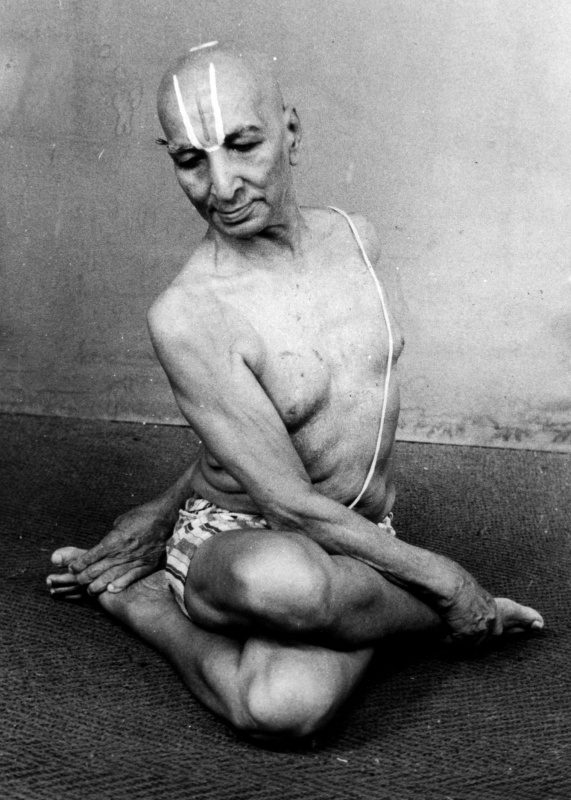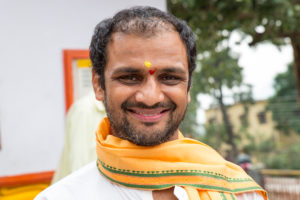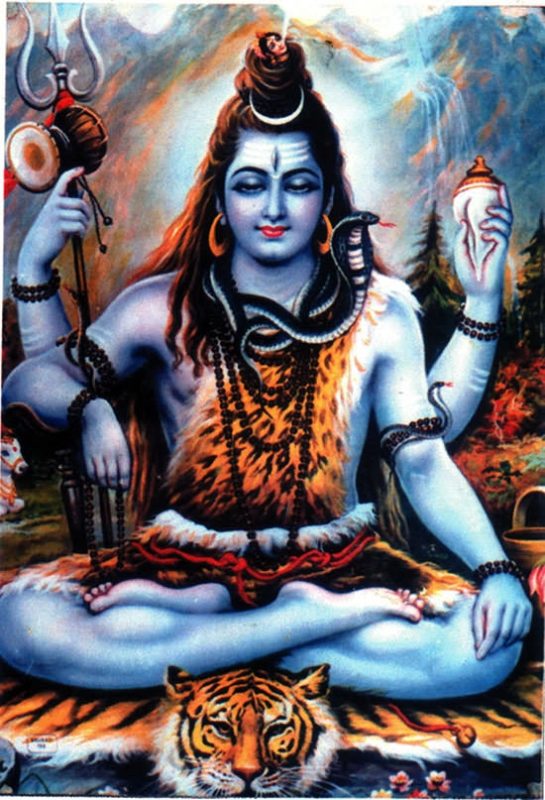Ashtanga Yoga is an ancient system of Yoga leading to ultimate personal freedom that we know from the text Yoga Sutras of Patanjali, compiled sometime between 500 BCE and 400 CE by the sage Patanjali in India who synthesized and organized knowledge about yoga from much older traditions.
An in-depth asana practice of the same name, and including the system stated above, was taught by Vamana Rishi in the Yoga Korunta. This text was imparted to Sri T. Krishnamacharya in the early 1900’s by his Guru Rama Mohan Brahmachari, and was later passed down to Sri Krishna Pattabhi Jois during the duration of his intensive studies with Sri Tirumalai Krishnamacharya; considered to be the father of modern yoga, beginning in 1927 when Jois was 12 years old. After many years of studying with his guru, in 1948 Pattabhi Jois opened the Ashtanga Yoga Research Institute in Mysore, India. When he passed in 2009, his grandson R. Sharath Jois became the current lineage holder and currently runs Sharath Yoga Centre in Mysore, India.
The following are aspects that are emphasized as the main components of Ashtanga Yoga and are credited to the book “Astanga Yoga Anusthana” by R. Sharath Jois.
Ashtanga Yoga means 8 limbed Yoga. Ashtau: 8, Anga: Limb

Patanjali’s Yoga Sutra describes the 8 limbs as such:
Yama: Observances and behaviors which regulate how we behave to others
- Ahimsa- nonviolence
- Satya- truthfulness
- Asteya- non-stealing
- Brahmacharya- celibacy
- Aparigraha- nonpossessiveness
Niyama: Commitments to ourselves, and daily principles to follow
- Sauca- purity and cleanliness
- Santosa- contentment
- Tapas- self-discipline
- Svadyaya- self-study
- Isvarapranidhana- devotion to God, surrender to the divine
Asana: physical yoga posture practice
Pranayama: breathing practice
Pratyahara: sense withdrawal
Dharana: concentration of mind
Dhyana: meditation
Samadhi: apsorption
Ashtanga Asana practice overview
Ashtanga Yoga has 6 sequences of postures, each with around 30 different sitting asanas (postures). All sequences start with Surya Namaskars (sun salutations) and the same core postures. Each sequence ends with backbends and the same finishing sequence of asanas. The first sequence, the Primary Series, can be a lifetime of practice and is called “Yoga Chikitsa” or body therapy. Yoga Chikitsa has many forward folding postures and jumps. These forward folding postures encourage lengthening of the hamstrings and contraction of the front side of the body, conditioning the inner organs and making the lower back more secure and supple. Patience and time are required to familiarize the body and mind with this practice and it may take many years to learn completely.
Vinyasa: Vinyasa means breathing and movement system. For each movement, there is one breath. For example, in Surya Namskar there are nine vinyasas. The first vinyasa is inhaling while raising your arms over your head, and putting your hands together; the second is exhaling while bending forward, placing your hands next to your feet, etc. In this way all asanas are assigned a certain number of vinyasas.
The purpose of vinyasa is for internal cleansing. Breathing and moving together while performing asanas makes the blood hot, or as Pattabhi Jois says, boils the blood. Thick blood is dirty and causes disease in the body. The heat created from yoga cleans the blood and makes it thin, so that it may circulate freely. The combination of the asanas with movement and breath make the blood circulate freely around all the joints, taking away body pains. When there is a lack of circulation, pain occurs. The heated blood also moves through all the internal organs removing impurities and disease, which are brought out of the body by the sweat that occurs during practice.
Sweat is an important byproduct of vinyasa, because it is only through sweat that disease leaves the body and purification occurs. In the same way that gold is melted in a pot to remove its impurities, by the virtue of the dirt rising to the surface as the gold boils, and the dirt then being removed, yoga boils the blood and brings all our toxins to the surface, which are removed through sweat. If the method of vinyasa is followed, the body becomes healthy and strong, and pure like gold.
After the body is purified, it is possible to purify the nervous system, and then the sense organs. These first steps are very difficult and require many years of practice. The sense organs are always looking outside, and the body is always giving into laziness. However, through determination and diligent practice, these can be controlled. After this is accomplished, mind control comes automatically. Vinyasa creates the foundation for this to occur.
Tristhana: This means the three places of attention or action: posture, breathing system and looking place. These three are very important for yoga practice, and cover three levels of purification: the body, nervous system and mind. They are always performed in conjunction with each other.
Asanas purify, strengthen and give flexibility to the body.
Breathing is rechaka- inhale and puraka- exhale. Both the inhale and exhale should be steady and even, the length of the inhale should be the same length and strength as the exhale. Breathing in this manner purifies the nervous system.
Dristhi is the place where you look while in the asana. There are nine dristhis: the nose, between the eyebrows, navel, thumb, hands, feet, up, right side and left side. Dristhi purifies and stabilizes the functioning of the mind.
For cleaning the body internally two factors are necessary, air and fire. The place of fire in our bodies is four inches below the navel. This is the standing place of our life force. In order for fire to burn, air is necessary, hence the necessity of the breath. If you stoke a fire with a blower, evenness is required so that the flame is not smothered out, or blown out of control.
The same method stands for the breath. Long even breaths will strengthen our internal fire, increasing heat in the body which in turn heats the blood for physical purification, and burns away impurities in the nervous system as well. Long even breathing increases the internal fire and strengthens the nervous system in a controlled manner and at an even pace. When this fire is strengthened, our digestion, health and life span all increase. Uneven inhalation and exhalation, or breathing too rapidly, will imbalance the beating of the heart, throwing off both the physical body and autonomic nervous system.
An important component of the breathing system is mula and uddiyana bandha. These are the anal and lower abdominal locks which seal in energy, give lightness, strength and health to the body, and help to build a strong internal fire. Without bandhas, breathing will not be correct, and the asanas will give no benefit. When mula bandha is perfect, mind control is automatic.
The six poisons: A vital aspect of internal purification that Pattabhi Jois teaches relates to the six poisons that surround the spiritual heart. In the yoga shastra it is said that God dwells in our heart in the form of light, but this light is covered by six poisons:
kama: desire
krodha: anger
moha: delusion
lobha: greed
matsarya: envy
mada: sloth
When yoga practice is sustained with great diligence and dedication over a long period of time, the heat generated from it burns away these poisons, and the light of our inner nature shines forth.
This forms the practical and philosophic basis of Ashtanga Yoga.
Krishnamacharya

Sri Tirumalai Krishnamacharya
Tirumalai Krishnamacharya (November 18, 1888 – February 28, 1989)was an Indian yoga teacher, ayurvedic healer and scholar. Often referred to as “The Father of Modern Yoga,” Krishnamacharya is widely regarded as one of the most influential yoga teachers of the 20th century and is credited with the revival of hatha yoga.
Krishnamacharya held degrees in all the six Vedic darśanas, or Indian philosophies. While under the patronage of the King of Mysore, Krishna Raja Wadiyar IV, Krishnamacharya traveled around India giving lectures and demonstrations to promote yoga, including such feats as stopping his heartbeat. He is widely considered as the architect of vinyāsa, in the sense of combining breathing with movement. Underlying all of Krishnamacharya’s teachings was the principle “Teach what is appropriate for an individual.” While he is revered in other parts of the world as a yogi, in India Krishnamacharya is mainly known as a healer who drew from both ayurvedic and yogic traditions to restore health and well-being to those he treated. He authored four books on yoga—Yoga Makaranda (1934), Yogaasanagalu (c. 1941), Yoga Rahasya, and Yogavalli (Chapter 1 – 1988)—as well as several essays and poetic compositions.
Some of Krishnamacharya’s students include many of yoga’s most renowned teachers: Indra Devi (1899–2002), K. Pattabhi Jois (1915–2009), B.N.S. Iyengar (born 1924), T. K. V. Desikachar (1938-2016), Srivatsa Ramaswami (born 1939), A. G. Mohan (born 1945), Avathuta H. H. Guru Dileepji Maharaj (born 1969), and Mark Whitwell (born 1959). Krishnamacharya was the brother-in-law of B.K.S. Iyengar (1918-2014), the founder of the style of yoga known as “Iyengar Yoga,” who credits Krishnamacharya with encouraging him to learn yoga as a young person in 1934.

Paramaguru Sharath Jois
From KPJAYI.ORG: Sharath R. Jois
Sharathji was born on September 29, 1971 in Mysore, India to Saraswathi Rangaswamy, daughter of ashtanga master Sri K. Pattabhi Jois. Growing up in a house full of yoga practitioners, Sharath learned his first asanas at age seven and experimented with postures from the primary and intermediate series until he turned fourteen. Though he spent the next three years focused on his scholastic education, earning a diploma in electronics from JSS in Mysore, Sharath knew that he would one day follow the ashtanga path blazed by his mother and legendary grandfather.
Sharath embarked on his formal yoga study at the age of nineteen. He would wake every day at 3:30 a.m. and cross the town of Mysore to his grandfather’s Lakshmipuram yoga shala. There, he would first practice and then assist his guru, Pattabhi Jois, a routine of dedication he has followed for many years.
Today, Sharath’s sincere devotion and discipline to the study and practice of yoga compels him to rise six days a week at 1:00 a.m. to complete his practice before the first students arrive at the K. Pattabhi Jois Ashtanga Yoga Institute, where he serves as Director.
Sharath is Pattabhi Jois’s only student who has studied and continues to practice the complete six series of the ashtanga yoga system. He presently resides in Mysore with his wife Shruthi, daughter Shraddha, and son Sambhav.
 Shiva is considered the Great Yogi who is totally absorbed in himself – the transcendental reality. He is the Lord of Yogis, and the teacher of Yoga to sages. As Shiva Dakshinamurthi, states Stella Kramrisch, he is the supreme guru who “teaches in silence the oneness of one’s innermost self (atman) with the ultimate reality (brahman).”
Shiva is considered the Great Yogi who is totally absorbed in himself – the transcendental reality. He is the Lord of Yogis, and the teacher of Yoga to sages. As Shiva Dakshinamurthi, states Stella Kramrisch, he is the supreme guru who “teaches in silence the oneness of one’s innermost self (atman) with the ultimate reality (brahman).”
The theory and practice of Yoga, in different styles, has been a part of all major traditions of Hinduism, and Shiva has been the patron or spokesperson in numerous Hindu Yoga texts. These contain the philosophy and techniques for Yoga. These ideas are estimated to be from or after the late centuries of the 1st millennium CE, and have survived as Yoga texts such as the Isvara Gita (literally, “Shiva’s song”), which Andrew Nicholson – a professor of Hinduism and Indian Intellectual History – states have had “a profound and lasting influence on the development of Hinduism”.
Other famed Shiva-related texts influenced Hatha Yoga, integrated monistic (Advaita Vedanta) ideas with Yoga philosophy and inspired the theoretical development of Indian classical dance. These include the Shiva Sutras, the Shiva Samhita, and those by the scholars of Kashmir Shaivism such as the 10th-century scholar Abhinavagupta. Abhinavagupta writes in his notes on the relevance of ideas related to Shiva and Yoga, by stating that “people, occupied as they are with their own affairs, normally do nothing for others”, and Shiva and Yoga spirituality helps one look beyond, understand interconnectedness, and thus benefit both the individual and the world towards a more blissful state of existence.